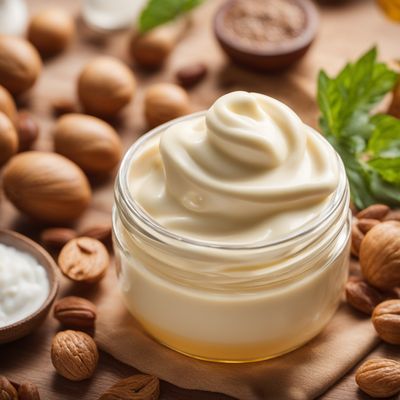
Ingredient
Cream, plain
The Velvety Elixir: Unveiling the Magic of Plain Cream
Cream, plain, is a dairy product that is obtained by skimming the fat from milk. It is characterized by its smooth and velvety texture, which adds a luxurious mouthfeel to dishes. Plain cream has a rich and slightly sweet taste, with a subtle hint of freshness. Its appearance is a creamy white color, and it has a thick consistency that can be easily whipped or poured.
Origins and history
The use of cream in cooking can be traced back to ancient civilizations, where it was highly valued for its ability to enhance flavors and create indulgent dishes. Cream has been a staple in European cuisine for centuries, particularly in countries like France and Italy, where it is used in classic recipes such as sauces, soups, and desserts. Over time, cream has become a beloved ingredient worldwide, finding its way into various culinary traditions and modern gastronomy.
Nutritional information
Plain cream is a good source of calories and fat, providing energy and contributing to the richness of dishes. It also contains essential vitamins, such as vitamin A and vitamin D, which are important for maintaining healthy skin, vision, and bone health.
Allergens
Plain cream contains milk, making it unsuitable for individuals with lactose intolerance or milk allergies.
How to select
When selecting plain cream, opt for products that have a high fat content, as this will ensure a richer and creamier result. Look for cream that is free from any off-putting odors or discoloration. Additionally, choose cream that is stored in a refrigerated section to maintain its freshness.
Storage recommendations
To maintain the freshness and quality of plain cream, it should be stored in the refrigerator at a temperature between 32°F and 40°F (0°C and 4°C). It is best to keep it in its original container or transfer it to an airtight container to prevent absorption of other flavors and odors.
How to produce
Producing plain cream at home requires separating the cream from milk. This can be done by allowing fresh milk to sit undisturbed in the refrigerator for several hours, allowing the cream to rise to the top. The cream can then be carefully skimmed off and collected.
Preparation tips
Plain cream can be used in a variety of ways, such as adding it to sauces, soups, or coffee, or using it as a base for desserts like whipped cream or ice cream. When using cream in cooking, it is important to avoid boiling it, as it can curdle. Instead, gently heat the cream over low to medium heat to incorporate it into dishes smoothly. To whip cream, chill it thoroughly before beating it with a whisk or electric mixer until it reaches the desired consistency.
Culinary uses
Plain cream is a versatile ingredient that is commonly used in both sweet and savory dishes. It is often added to sauces, such as Alfredo or béchamel, to create a creamy and luscious texture. Cream is also a key component in desserts like panna cotta, custards, and mousses, providing a smooth and indulgent finish. Additionally, it can be whipped and used as a topping for cakes, pies, and hot beverages.
Availability
Plain cream is commonly available in most regions where dairy products are consumed. It is widely produced and can be found in grocery stores, supermarkets, and farmers markets.

